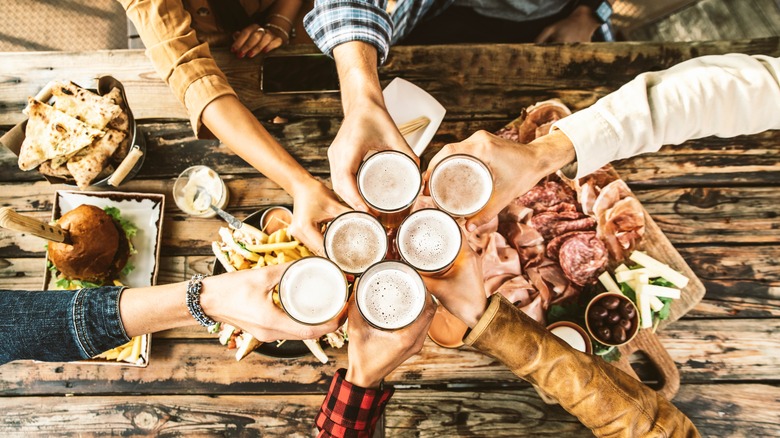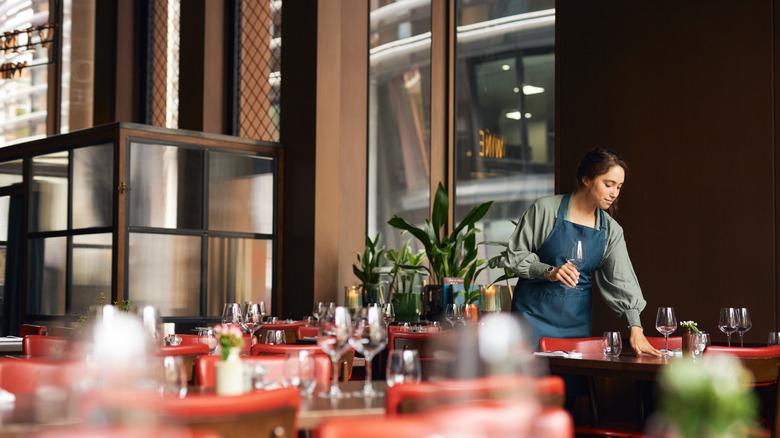The 'Golden' Menu Ratio Restaurants Use To Avoid Overwhelming Guests
There are two types of menus: The ones with so many options that it takes you 20 minutes to decide, and the more reasonable one-pager, which fits a fair number of appetizers and entrées onto one full page and isn't too overwhelming. Depending on who you are, you might prefer either one.
Certain restaurants have reputations for having unbelievably full menus, though the pandemic did have restaurants simplifying menus due to inflation and labor shortages. Still, the diner concept remains. In 2019, even The New York Times wrote about the vast length of diner menus and begged the question: how did they get so long? It turns out this mostly happened during the 1950s, when diners were forced to compete with the uprise in fast food chains. On the other hand, some upscale restaurants, such as those highly acclaimed, impossible-to-get-a-reservation types, offer tasting menus only, where guests don't even choose what's brought out to them — that's up to the chef.
While every restaurant has its choice in how and what it serves its patrons, there is actually something known as a "golden" menu ratio that many restaurants follow in order to give their customers the just-right number of options.
What is the golden menu ratio?
Preparing a restaurant menu is twofold. First and foremost, it must include choices the consumer will want to order; flavor pairings need to be equally unique and appealing, or at least match the restaurant's vibe (you probably won't find Almas caviar at your local pub or mozzarella sticks at a Michelin-Star spot). Beyond that, the kitchen needs to have the staff and equipment to (hopefully) cook everything fresh. Unless the restaurant is providing a bunch of frozen appetizers, it likely can't offer 20 options.
Here's where the golden rule of menus comes in. Menu engineer Gregg Rapp told Mental Floss that many restaurants aim to have seven appetizer and entrée choices for consumers because it's considered the perfect number. "When we include over seven items, a guest will be overwhelmed and confused, and when they get confused, they'll typically default to an item they've had before," Rapp said, which means they won't be willing to try something new. Of course, having too few items could leave customers wanting more.
Menu language makes a difference, too, according to Reader's Digest; think of it like fluffing up a dish's resume. Restaurants purposely make items sound as delectable as possible to entice you to order them.
Restaurants use other tricks on customers, too
It's not just about getting a customer to try something new. It's also about getting them to spend money. That's why Mental Floss says some restaurants intentionally leave out the "$" next to the price, or list something at $19.95 instead of $20; $20 puts it into a whole new dollar bracket.
It's also the reason fast food and fast-casual restaurants tend to offer bundles. Go Banking Rates says that bundling items, such as offering a combo deal that includes fries and drinks, gets the customer to spend more money without costing the restaurant more. And you've probably noticed that restaurants often encourage or allow you to wait at the bar while they get your table ready; this adds at least one more drink to your tab.
Next time you're dining out, don't read the restaurant menu wrong. Instead, pay attention to the way restaurants might be tricking you into what you order. Take a look at the prices, the number of choices, and whether or not they offer combination deals that could be coaxing you into spending more.


